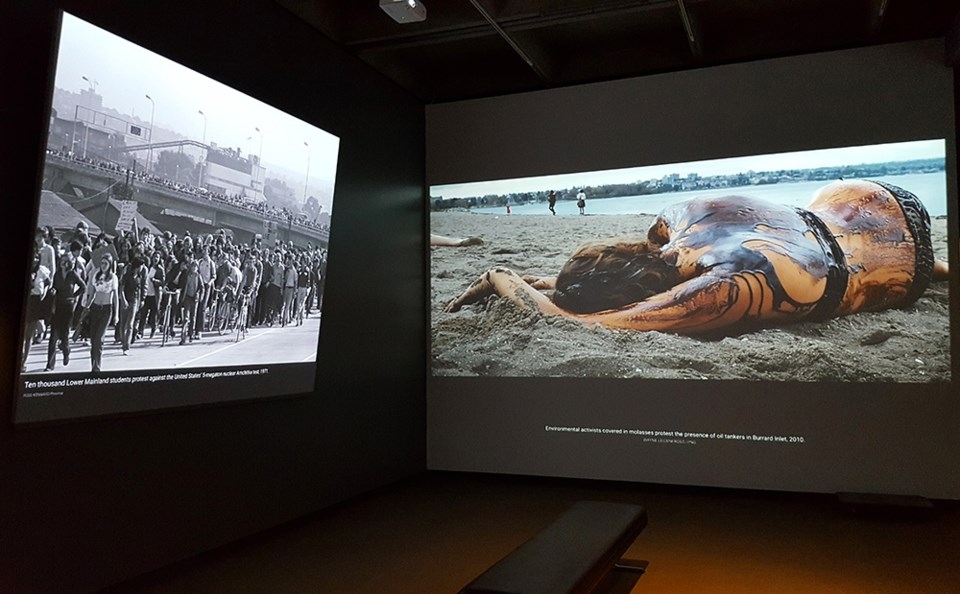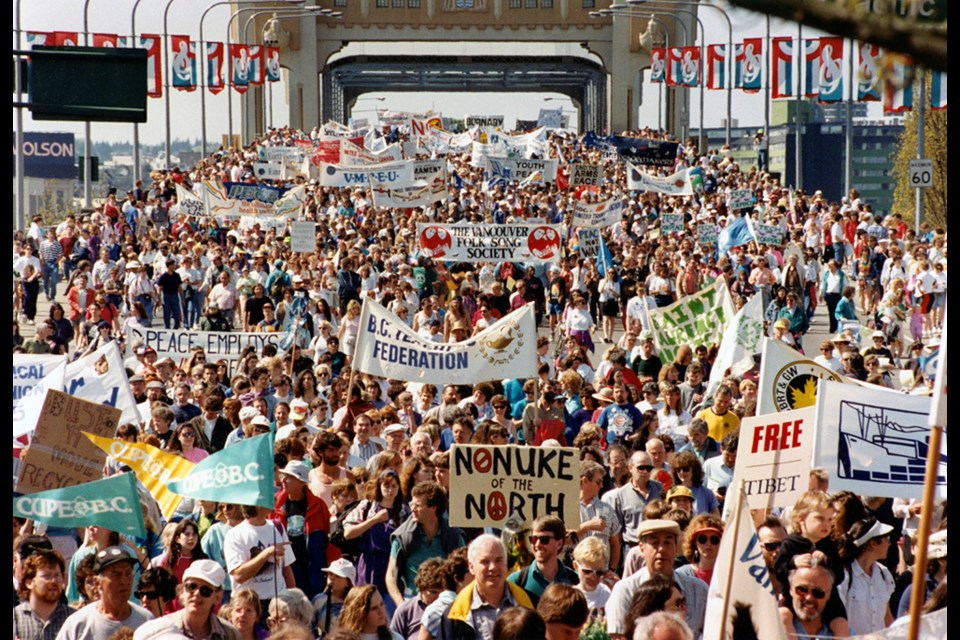Ěý
Hockey’s not the only sport in Â鶹´«Ă˝Ół»with rioting fans.
The Stanley Cup riots of 1994 and 2011 were landmark events in the city’s history, causing dozens of injuries, hundreds of arrests and millions of dollars worth of damage. But CFL fans aren’t so innocent, either. Violence flared on Â鶹´«Ă˝Ół»streets after Grey Cup games here in 1958, 1963 and 1966, the latter two leading to more than 300 arrests each.
It’s one of the many surprising historical facts that emerge from , a new exhibition at the that charts protests and mass unrest in the city through the photo archives of The Province and Â鶹´«Ă˝Ół»Sun newspapers.
Think affordability is a new hot topic? Photos show Vancouverites protesting at the start of the 20th century. Activists for Indigenous rights have been making their voices heard for a similar amount of time, other pictures reveal.
The exhibition collects 650 images from the newspapers’ extensive archives, depicting a range of activist moments from labour protests early in the city’s history right up to the local against the newly inaugurated U.S. president in January.
The images – most of them projected onto screens as large as 20 by 16 feet, others backlit – have been grouped into six rough themes: labour activism, social justice, anti-government, environmentalism, Indigenous rights and riots.
The main room of wall-to-wall projections, which features a soundtrack of crowds chanting and protest choirs singing, is a little disorienting at first. It was planned that way, says exhibition co-curator and museum director Viviane Gosselin. It takes a few minutes to find your feet in any large protest crowd, she explains. But once you’ve adjusted, you can start admiring the power of each work and the artistry of photojournalism.

Ěý
In a second room, which Gosselin refers to as “Ground Zero,” a replica of the steps at the Â鶹´«Ă˝Ół»Art Gallery has been built, with more projected photos charting the history of protests at probably the city’s most popular gathering site. Another screen encourages visitors to share pictures of their own protests.
There are several particular things about Â鶹´«Ă˝Ół»that helped foster a tradition of activism. Gosselin believes its initial function as a port and resource town was crucial, given the consequent influence of organized labour.
“We have logging and fishing, and with that came solid, powerful unions and so that trade attribute of people organizing around work,” Gosselin says.
“That ability to organize and mobilize is something that people learned,” she adds. “… Really, its contagious, the more you do it, the more people around you will emulate that. This is part of the toolkit of people organizing.” She cites the Arab Spring, which saw uprisings in one country after another, as a prime example of this.
As well, Â鶹´«Ă˝Ół»has always been far from federal control, at least geographically speaking, and in the past aligned itself more with the social justice activism of the U.S. West Coast, such as the anti-Vietnam War and nuclear disarmament movements. The resource industries that spawned labour activism then became the target of environmental protests, amid which was born.
Then there’s the particular position of the Indigenous peoples of B.C.
“The fact that we are sitting on unceded Coast Salish territory and there’s only a few claims that have been settled, there was this leverage that Indigenous people had in questioning the land grab from the beginning,” says Gosselin. But the long history of Indigenous activism revealed by the exhibition is a stark reminder of how relatively little has changed for B.C.’s First Nations over the past century.
“These are enduring issues and they change at a glacial pace,” Gosselin says.
Assembling the exhibition has been a labour of love for co-curator Kate Bird, a librarian for 25 years at Pacific Newspaper Group, The Province and Â鶹´«Ă˝Ół»Sun’s parent company. She describes it as her “mission in retirement” to unearth the treasures of the newspapers’ private archives.
“I just love this collection and I’m just so privileged to bring these things to light. A lot of them just haven’t been seen, or not seen since they ran in the paper,” she says.
For Bird – who also curated the recent book and exhibition from the PNG archives – the power of these photos is in their role as documents; whether supporting known facts or events or shedding light on barely known protests or issues.
It also raises concerns over the dwindling numbers of journalists, including photojournalists, who document a city’s history.
“It’s terribly worrying,” Bird says. “I think a big aspect of this is documenting. Even though there are so many [protests] that are in the show and were documented, think of how many protests weren’t. And if there aren’t journalists and photojournalists to cover these things, that’ll be a huge loss. It’s a very important part of our society that needs to be brought to light.”
City on Edge: A Century of Â鶹´«Ă˝Ół»Activism runs Sept. 28-Feb. 18 at the Museum of Vancouver. $19/$16. by Kate Bird (Greystone Books) is out now. Kate Bird will be reading with authors Aaron Chapman, Wayde Compton and Charles Demers at the Â鶹´«Ă˝Ół»Public Library on Oct. 5, 7 p.m.


